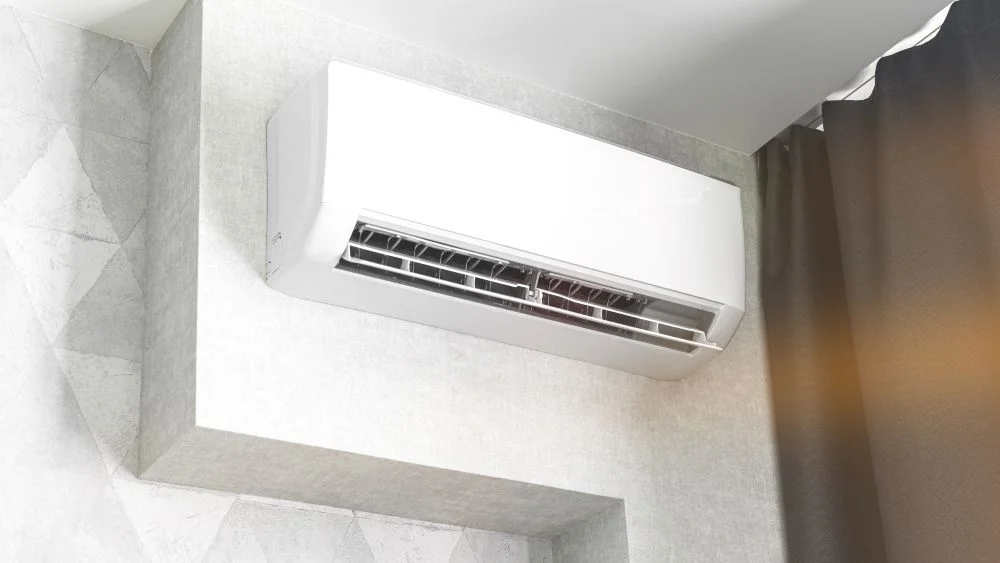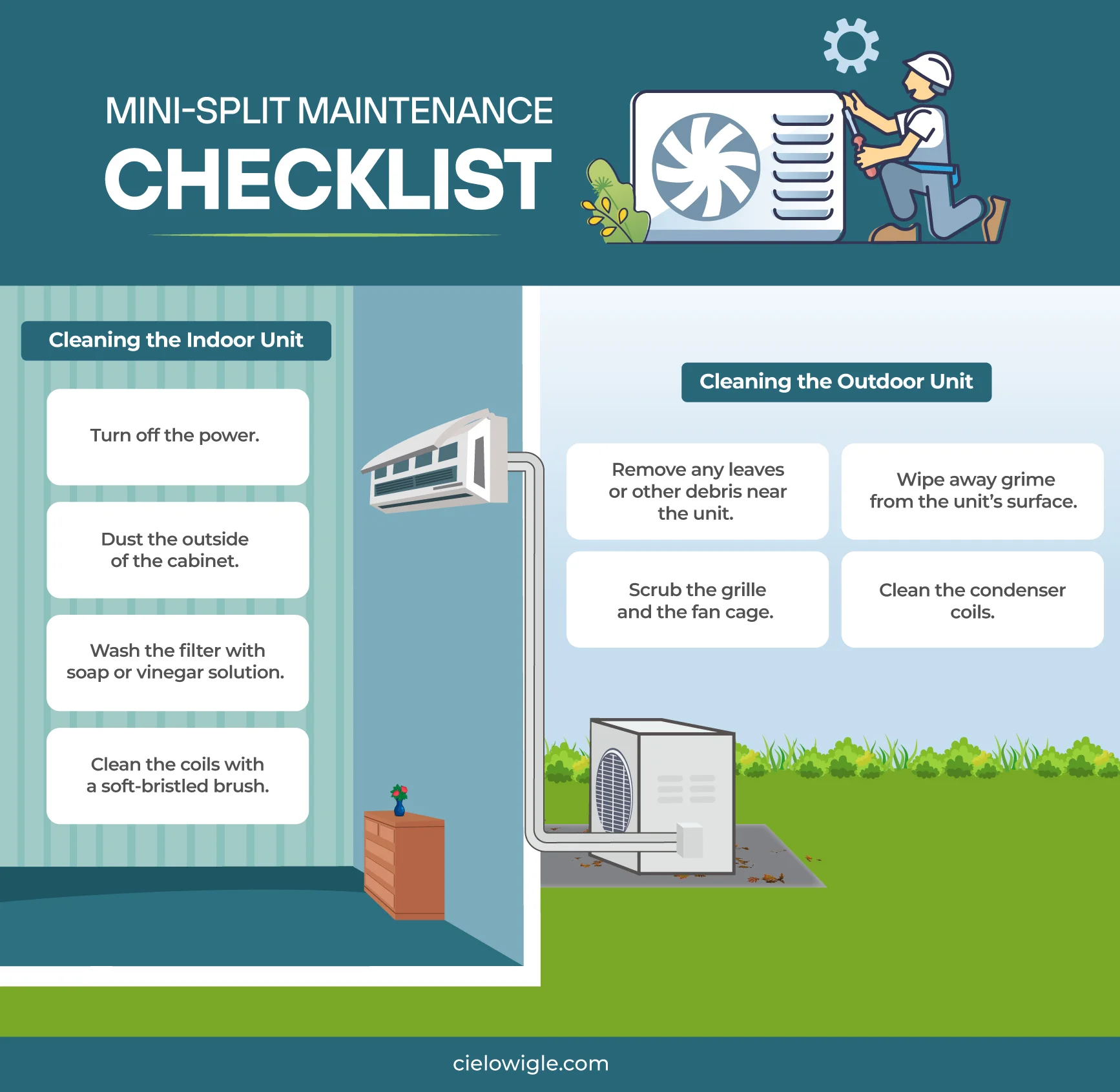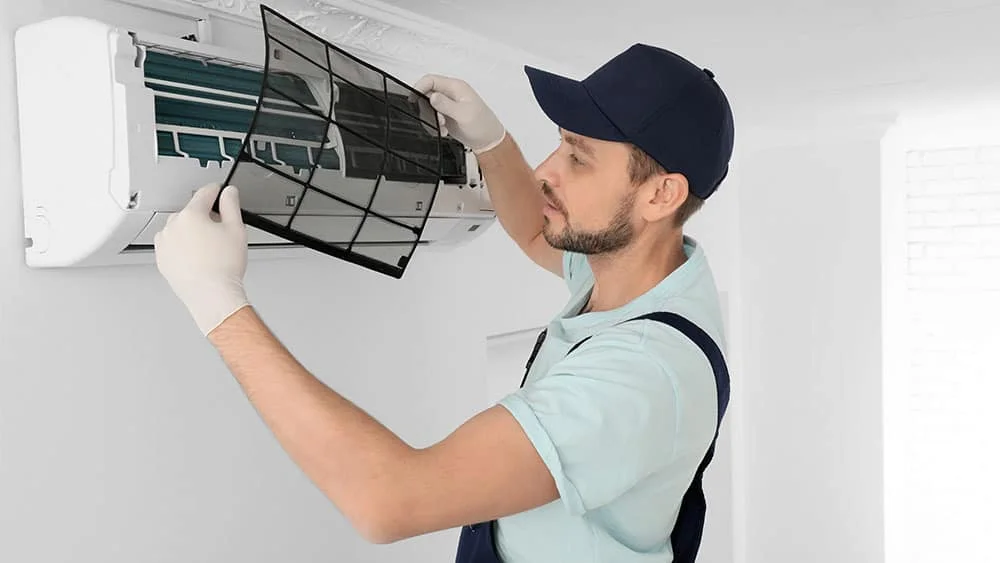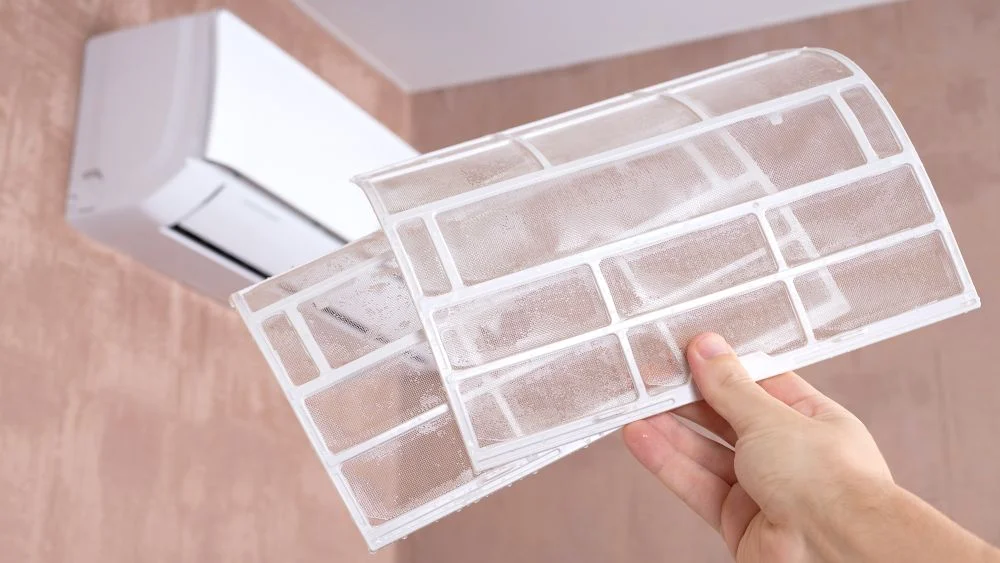
Key Takeaways
- Regularly clean both the indoor and outdoor units to ensure your mini-split operates efficiently.
- Clean filters and coils, and keep the area around the outdoor unit clear.
- Schedule an annual professional tune-up for more complex maintenance tasks.
Your mini-split system works tirelessly to keep your home comfortable. To ensure it continues to perform at its best, regular mini-split AC maintenance is crucial. Neglecting routine upkeep can lead to reduced efficiency, higher electricity bills, and potential system failure.
From cleaning filters to removing dirt around the outdoor unit, this guide will explore essential tasks for keeping your unit in top shape. By sticking to a mini-split maintenance checklist, you can help ensure that your unit runs smoothly for years to come.
Mini-Split System Basics

A mini-split system offers a versatile and efficient solution for maintaining a comfortable environment in individual rooms or zones within a home. While some are cool-only units, others, known as mini-split heat pumps, offer the added benefit of both heating and cooling capabilities.
These units are designed to provide targeted heating and cooling without requiring extensive ductwork. They release the conditioned air directly where they are mounted, preventing energy losses that are common with ducted systems. This also makes the mini-splits easy to install.
The mini-split system operates on a heat transfer mechanism. In summer, it takes the heat from your home and ejects it outside. In winter, the process is reversed, and the outdoor heat is transferred inside. It has an indoor unit and an outdoor unit, which are connected by copper tubing that allows the refrigerant to flow between them.
Ductless Mini-Split Maintenance

Over time, with use, dust, dirt, and other pollutants can build up in your mini-split, affecting its performance and air quality. Regular cleaning of the filters, coils, and drainage components helps maintain optimal airflow and prevents potential issues such as reduced efficiency and AC breakdowns. While some tasks, like changing air filters, can be handled by homeowners, it’s recommended to have a certified HVAC technician perform more comprehensive mini-split maintenance tasks, such as inspecting the electrical components.
For thorough cleaning and inspections, aim for at least once a year, though twice yearly is often advised, especially for mini-split heat pumps that operate all year. Schedule HVAC maintenance in both spring and fall to prepare the unit for the upcoming high-demand seasons.
Related: The Ultimate Spring HVAC Maintenance Checklist
Cleaning the Indoor Unit

The indoor unit of a mini-split system is a rectangular cabinet that houses the evaporator coils and the AC filter. You can easily clean both these components yourself.
- Turn off the Power
Before starting the cleaning process, unplug your unit. If it’s hardwired into the circuit, turn off the circuit breaker.
- Dust off the Cabinet
Take a clean cloth and remove the dust from the outside of the cabinet. You can also use a small vacuum for cleaning.
- Clean the Filters

Air filters play a key role in capturing dust and indoor air pollutants. If they are left uncleaned, they become clogged, leading to several issues. A dirty filter can hinder airflow, causing the system to work harder to maintain your desired temperature. This not only increases energy consumption but also puts unnecessary strain on the system. A clogged filter can also degrade indoor air quality by allowing debris to circulate in your home.
Cleaning the filters is simple. Remove them from the indoor unit and vacuum them to remove most of the dust. For thorough cleaning, wash them with a water and vinegar solution. Let them dry, and then reinsert them. If the filters are too dirty to clean effectively or appear damaged, replacing them is the best option.
To ensure optimal performance, it is best to clean your filters every two weeks and replace them every three to four months.
To make sure you stay on top of cleaning your filter, you can invest in a mini-split thermostat like the Cielo Breez Max. Equipped with many smart features that make indoor temperature control efficient, it also sends helpful filter cleaning reminders.
Your best choice to make any mini-split, window,
or portable AC smart. Enhance your comfort and savings.

- Clean the Evaporative Coils
AC coils play a crucial role in the cooling process. Over time, dust accumulates on them, which can interfere with their ability to transfer heat effectively.
There are two types of AC coils: evaporator coils located in indoor units and condenser coils in outdoor units.
To clean the evaporator coils, use a soft-bristled brush to remove the dust and debris. Brush lightly to prevent the delicate fins from getting damaged. You can also use an AC coil cleaner for deep cleaning. For indoor coils, use a rinse-free cleanser, as you won’t be able to hose it down. Spray the AC coil cleaner as required and let it sit for 5-10 minutes. Wipe it clean with a soft cloth. To prevent mold growth, it’s best to spray a mildewcide on the coils after you are done with cleaning. Here’s everything you need to know about AC coil cleaning.
Cleaning the Outdoor AC Unit

Outdoor AC unit maintenance involves clearing the area around it and cleaning the components like condenser coils.
- Clear the Debris Around the Outdoor Unit
Remove any leaves, grass clippings, or other debris that might have accumulated near the unit. These can block airflow and hinder the unit’s ability to effectively release heat. If you have plants or bushes near the outdoor unit, make sure to keep them trimmed.
During the colder months, mini-split systems can face the challenge of ice buildup on their outdoor units. Carefully clear it away using a soft tool or warm water, being cautious not to damage the unit.
- Wipe Down the Exterior
Take a clean cloth to wipe away any dirt or grime from the unit’s surface. Next, take a cleaning brush and scrub both the grille and the fan cage of the outdoor unit. While you’re at it, clean the fan blades as well since any dirt on them can transfer to the condenser coils. When you are done cleaning the fan blades, apply a few drops of lubricant oil to the fan spindles for smooth operation.
- Deep Clean the Condenser Coils
Take off the cover and use a wet/dry vacuum to remove all the dust inside.
Locate the condenser coils and sweep the dust away with a soft brush. For deep cleaning, you can also hose them down, but avoid using high pressure, as it can damage the fins. You can replace the hose nozzle with a needle sprayer. It is specially designed to clean the condenser coils.
Another way to clean the condenser coils is to use a homemade vinegar and water cleaning solution or opt for a commercial cleaner. Spray the coils with the cleaner and let them sit for 5 to 10 minutes. Then rinse with a garden hose.
Professional Mini-Split AC Maintenance
You should schedule a professional tune-up to handle more complicated maintenance tasks at least once a year.
Some of the tasks the technicians perform include:
- Low refrigerant levels can lead to frozen evaporator coils, driving up energy costs and potentially causing significant damage. A technician will check for a refrigerant leak and, if detected, will repair the leak and replenish the refrigerant as required.
- The HVAC technician will check the electrical AC components of both the indoor air handler and outdoor condenser, including wire connections. For optimal performance, these connections often need cleaning, tightening, and rust-preventing lubrication.
- The reversing valve allows your mini-split heat pump to switch between heating and cooling modes. If the valve isn’t working correctly, you may face issues when changing between heating and cooling. Professionals will evaluate the valve’s performance during mini-split maintenance and check if it needs replacement.
The Takeaway
Regular mini-split maintenance is crucial to ensuring its optimal performance, efficiency, and longevity. By performing routine maintenance activities like cleaning filters, checking condenser coils, clearing the surrounding area, and inspecting for any signs of wear or damage, you can prevent costly AC repairs and keep the system running smoothly. Preventative AC maintenance not only extends the life of your unit but also enhances indoor air quality and keeps energy bills in check.
Frequently Asked Questions
How Long Do Mini Splits Last?
Mini split systems are built to last! On average, a well-maintained mini split can last anywhere between 15 to 20 years. Regular cleaning and maintenance play a big role in helping your system reach its full lifespan. If you're taking care of your unit properly, you can expect it to keep your space comfortable for a long time.
Do Mini-Splits Filter Air?
Yes, mini splits have built-in air filters that help improve indoor air quality. These filters trap dust, allergens, and other particles, making your home’s air fresher and cleaner. Cleaning or replacing the filters regularly keeps them working effectively.
How Much Does Mini-Split Maintenance Cost?
Professional mini split cleaning costs usually range between $300 and $550. It includes tasks such as thoroughly cleaning the unit, lubricating moving parts, and tightening electrical connections.








